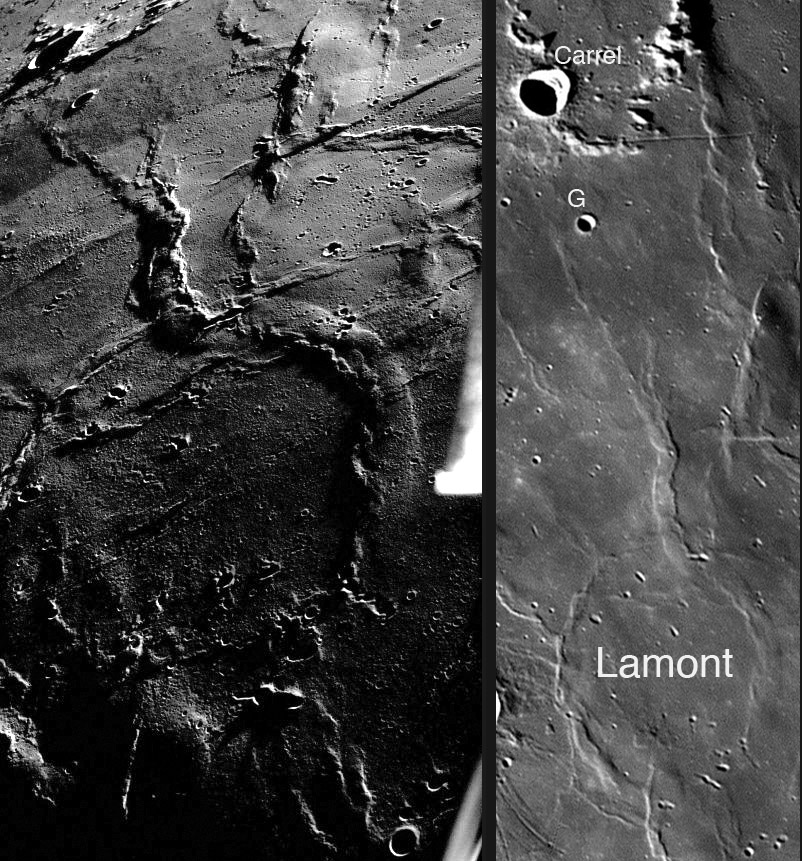|
|
| (5 intermediate revisions by the same user not shown) |
| Line 1: |
Line 1: |
| | __NOTOC__ | | __NOTOC__ |
| | =A Lost Gem= | | =A Lost Gem= |
| | + | <!-- Start of content --> |
| | <div class="post" id="post-1560"> | | <div class="post" id="post-1560"> |
| | | | |
| | <div class="storycontent"> | | <div class="storycontent"> |
| | <p>[[File:AS11-37-5438-Wirths-LPOD.jpg|AS11-37-5438-Wirths-LPOD.jpg]]<br /> | | <p>[[File:AS11-37-5438-Wirths-LPOD.jpg|AS11-37-5438-Wirths-LPOD.jpg]]<br /> |
| − | <em>left image from ["" Apollo 11-37-5438]; right image from [http://www.lpod.org/?m=20060918 Mike Wirths ]</em></p> | + | <em>left image from ["" Apollo 11-37-5438]; right image from [[September_18,_2006|Mike Wirths ]]</em></p> |
| − | <p>Danny Caes has done it again - he has [http://the-moon.wikispaces.com/Lamont found] a 38 year old Apollo 11 image that provides a dramatically different perspective of a well-known feature. I don’t remember ever seeing this image before, and I am sorry I missed it because it gives a remarkable view of an odd landform. Lamont is a strange collection of circular and radiating mare ridges in southwestern Mare Tranquilitatis. It looks like a mega-ghost crater, except its double ring suggests that its a ghost basin. Calling it a <em>ghost</em> simply means that it is a former structure -perhaps like the two ring [http://the-moon.wikispaces.com/Grimaldi Grimaldi Basin] - buried under the mare lavas. The very low Sun and very high resolution of the Apollo image reveals a number of features not usually seen on terrestrial images such as Mike’s excellent shot (right). The east arc of the Lamont ring is made up of two morphologically different structures - a broad, flat ridge, with a narrow braided inner piping. The unnamed ridge that extends northward has a similar two component structure, but the piping is on the opposite side - I don’t know why. Most of the western rim of Lamont isn’t visible but a line of three swells cuts the corner like a chord. Secondary craters are everywhere - from Theophilus? - and the roughness of the mare surface is very pronounced. What is most amazing is the abrupt changes in the surface north of Lamont. There is a well known swath of material that is here shown to be smoother, brighter and less cratered than adjacent maria. Its north edge (diagonal across the top of the Apollo image) is totally abrupt, and the south edge is more transitional. The low lighting shows that this part of the bright swath parallels two or more sharp ridges inside the swath. The swath appears to be younger lava flow the partially [http://www.lpod.org/?m=20060519 wraps] around Lamont, but its source is not apparent.</p> | + | <p>Danny Caes has done it again - he has [https://the-moon.us/wiki/Lamont found] a 38 year old Apollo 11 image that provides a dramatically different perspective of a well-known feature. I don’t remember ever seeing this image before, and I am sorry I missed it because it gives a remarkable view of an odd landform. Lamont is a strange collection of circular and radiating mare ridges in southwestern Mare Tranquilitatis. It looks like a mega-ghost crater, except its double ring suggests that its a ghost basin. Calling it a <em>ghost</em> simply means that it is a former structure -perhaps like the two ring [https://the-moon.us/wiki/Grimaldi Grimaldi Basin] - buried under the mare lavas. The very low Sun and very high resolution of the Apollo image reveals a number of features not usually seen on terrestrial images such as Mike’s excellent shot (right). The east arc of the Lamont ring is made up of two morphologically different structures - a broad, flat ridge, with a narrow braided inner piping. The unnamed ridge that extends northward has a similar two component structure, but the piping is on the opposite side - I don’t know why. Most of the western rim of Lamont isn’t visible but a line of three swells cuts the corner like a chord. Secondary craters are everywhere - from Theophilus? - and the roughness of the mare surface is very pronounced. What is most amazing is the abrupt changes in the surface north of Lamont. There is a well known swath of material that is here shown to be smoother, brighter and less cratered than adjacent maria. Its north edge (diagonal across the top of the Apollo image) is totally abrupt, and the south edge is more transitional. The low lighting shows that this part of the bright swath parallels two or more sharp ridges inside the swath. The swath appears to be younger lava flow the partially [[May_19,_2006|wraps]] around Lamont, but its source is not apparent.</p> |
| | <p>[mailto:tychocrater@yahoo.com Chuck Wood]</p> | | <p>[mailto:tychocrater@yahoo.com Chuck Wood]</p> |
| | <p><strong>Related Links:</strong><br /> | | <p><strong>Related Links:</strong><br /> |
| | Rükl plate 35</p> | | Rükl plate 35</p> |
| − | <p align="center"><em>Get ready for Christmas giving and support LPOD when you buy ANY book from Amazon thru [http://www.lpod.org/?page_id=591 LPOD!]</em></p> | + | <p><b>Yesterday's LPOD:</b> [[December 1, 2007|Another Lunar Atlas?]] </p> |
| | + | <p><b>Tomorrow's LPOD:</b> [[December 3, 2007|Translucent Dreams]] </p> |
| | + | <!-- Removed reference to store page 2 --> |
| | </div> | | </div> |
| − | ---- | + | <!-- End of content --> |
| − | ===COMMENTS?===
| + | {{wiki/ArticleFooter}} |
| − | Click on this icon [[image:PostIcon.jpg]] at the upper right to post a comment.
| |




